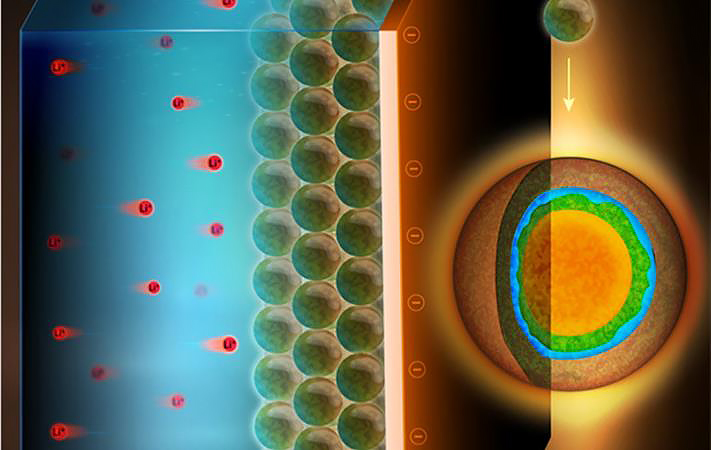Research on Li Ion battery anode using tin oxide shows promising results

Schematic illustrating Li-ion battery structure. Design by Olga Kasimova
Recent research at KAUST has produced a promising Li ion battery anode using tin oxide (SnO2), which has much higher theoretical storage capacity compared to the current commercial Li ion battery anodes, which are made of graphite.
However, tin oxide has one serious problem: it undergoes severe volume changes as it interacts with the battery’s electrolyte during the charging and discharging cycle of the battery.
To combat this issue, Nulati Yesibolati, a recent KAUST master’s degree graduate from the group of Husam Alshareef, Professor of Material Science and Engineering, used atomic layer deposition to coat the surface of the SnO2 anode with a few atomic layers of another electrochemically inactive oxide (HfO2) to reduce the reaction of SnO2 and the battery electrolyte.
The atomic layer coating of HfO2 significantly reduced the volume change of the SnO2 anode, but at the same time still allowed the Li ion diffusion through the thin layer of HfO2 to reach the SnO2 anode and charge the battery. Yesibolati’s technique resulted in almost 56% improvement in the storage capacity of the SnO2 anode, and also improved its cycling stability in a significant way.
Although the use of other atomic layer deposition coatings has been reported previously, what is unique about Yesibolati’s approach is that it appears to be quite insensitive to HfO2 thickness. “Amazingly, HfO2 layers as thick as 20 nm were used, and we could still see the improvement in battery performance,” noted Prof. Alshareef. The authors attribute this phenomenon to the amorphous structure of the HfO2 layer, and possibly the catalytic effect of hafnium (Hf), which allow easier diffusion of the Li ions toward the SnO2 anode.
Yesibolati's research on this project has been selected as a VIP paper and was recently published online in the Wiley journal Small (DOI: 10.1002/smll.201303898) and has resulted in additional publications.
Please enable JavaScript to view the comments powered by Disqus. comments powered by Disqus
